|
PROLOGUE
The adventure really began with the Sky at Night and Patrick telling us all that he was going to see the longest eclipse of the century, and me wondering why he should have all the luck. Later on, I reflected that I still had a few hundred pounds worth of shares which were rapidly losing value as inflation proceeded, and that it was now or never.
On looking up the track of the eclipse I realised that I'd have to rely on being able to join an organized party to see it; I felt sure that with all the adventure holidays, special interest holidays, etc., that one sees advertised, there must surely be something planned for the eclipse of the century.
Chance stepped in. In November, a travel agency, Transolar Travel, advertised a trip to see the last Apollo lift-off. Wondering if they'd think I was a nut-case, I wrote to ask if they had any arrangements for the eclipse. Back came a wonderful brochure – a cruise to Mauritania arranged in conjunction with the BAA – travel in comfort and see the eclipse! Only one snag – cruise fully booked: but they hoped to charter another ship. Phoned the agency. It seemed rather dubious about the second ship but promised to let me know.
I began to look at share prices, the market seemed good, and I thought there might be a temporary set-back when we joined the EEC in January, so took the plunge, sold the shares, realised £600, which I put in the bank.
Towards the end of February, I phoned the travel agency again. The second ship was definitely off, they were trying to organise a party flying to Paris, then to Dakar, but at a cost far above my limits. Had to content myself with putting my name down on the waiting list for the Monte Umbe. Not much hope.
In the next few weeks, I must have written to dozens of travel agencies; I nearly wrote to Patrick himself; but everywhere drew blanks. I decided to write it off and we started thinking about going to Amsterdam.
THEN . . .
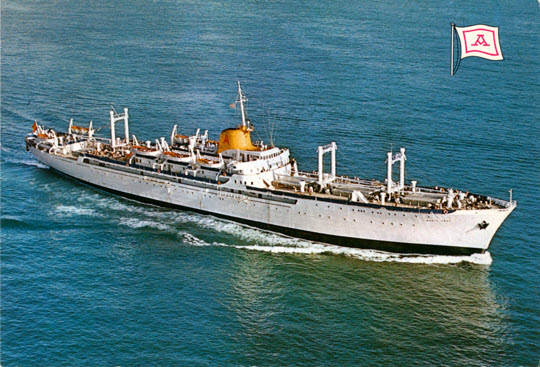
Monte Umbe, Naviera Aznar, S.A., Bilbao
Saturday 23rd June
Boat drill in the afternoon, Captain's cocktail party at night, and first taste of caviare. Very nice. Table-mates, who started out modestly, now knocking back free wine as fast as we are! There are bottles of red and white wine on the table at every meal (except breakfast, of course). It's a good job the ship is fairly steady!
Chat with hostess, who says 114 crew to 320 passengers. Normal passenger list 300, so ship slightly overbooked for eclipse cruise – hostesses left cabinless and dossing down in odd corners.
Sky overcast tonight. Due to cross Bay of Biscay tomorrow. By this time, the cruise staff were wondering what had hit them as their efforts to turn the ship into a floating Butlins were firmly discouraged; and one of the hostesses was heard to declare that they had got a right weird mob this time. The weird mob knew exactly what they wanted to do. Deck games were left to the children while the amateur astronomers set up and tested their equipment.
Sunday 24th June
Off the coast of Northern spain this afternoon. Sunbathing on deck. General rush to rail with binoculars every time ship spotted – Russian vessel, fleet of fishing-boats, a sailing-ship having a rough time by the looks of it. Read "La Maison de Claudine", by Colette. Everybody busy scribbling notes and journals of the voyage.
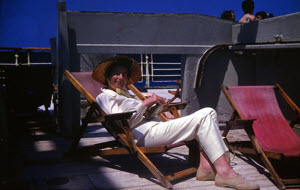 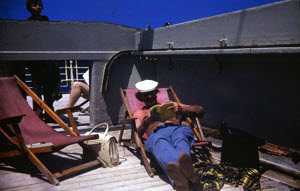
The ship sails in the centre of a huge, round horizon. The sea is indigo. I never really believed in this colour before – it's just makeweight between blue and violet to bring the colours of the rainbow up to the sacred number of 7. But it does exist and it was there.
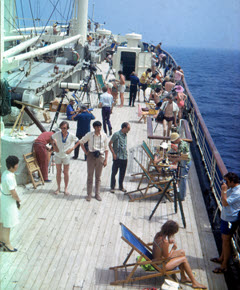 More equipment set up on the foredeck; among it, a rabbit hutch with a dish of water outside for the rabbits We learned later that this was some sort of experiment to measure evaporation or whatever. It belonged to Bill, the weatherman, to whom the eclipse was nothing compared to the thrill of the force 9 gale we met on the way back! [I ventured out on deck. Panic!]
More equipment set up on the foredeck; among it, a rabbit hutch with a dish of water outside for the rabbits We learned later that this was some sort of experiment to measure evaporation or whatever. It belonged to Bill, the weatherman, to whom the eclipse was nothing compared to the thrill of the force 9 gale we met on the way back! [I ventured out on deck. Panic!]
As dark at 9:30 as it was at 10:30 last night. The sun set almost straight into sea. The sky clear and I saw Skylab passing over, and its rocket. Also Venus and I think Mercury. Strange to see Polaris so low in the sky, and Arcturus so high. Antares well placed to south.
Unfortunately for Bill, the weatherman, people gazing heavenwards on the lookout for Skylab occasionally triped over his rabbit hutch, upsetting the water and ruining the records. But Bill took it all with good humour.
Monday 25th June
Cloudy at first but soon cleared to brilliant sunshine. Sun nearly overhead. Broke out sunhat. Rabbit hutch once again shipshape and in working order. Talks a.m. on the stars in the tropics and the sky during the eclipse.
Rumours are going round of murmuring and discontent among the ship's hostesses, who organise things and other entertainments for the benefit of passengers. There's a total lack of participation. Probably 50% of passengers have never even heard of bingo, so can't really be blamed.
Dull p.m. so went to see film "Travels with my aunt". Boring, only dull moments of the trip so far.
Ship's party tonight, held in the dining-room, the largest room in ship, taking up the full width, so good turnout must have been expected, but only half a dozen people turned up. Rest probably unaware such things as ship's parties existed. A party of about 200 were out star-gazing on the deck. Hostesses' worst fears about astronomers obviously realised!
A special franking for mail going from the ship was announced yesterday, but nothing more was heard until today, when it was announced over the Tannoy that Mr. Anslow would be in Información to stamp mail. Rushed for cards, borrowed envelopes from H., managed to get all stamped before large Q formed. In the afternoon, a second stamping session was held, Q's larger than ever. Got some cards showing the ship and had them stamped. By this time, there was a charge of 10 ptas for the service.
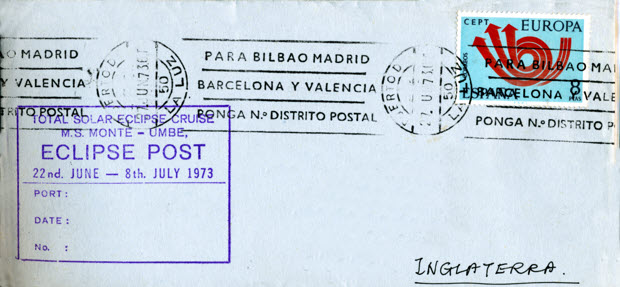
Tuesday 26th June
Sea a little rougher during night, cloudy morning but clearing up. There was a talk on photographing eclipse this morning. The talks are so popular – not like the bingo sessions – that we have to secure places about an hour in advance, sitting on a hard chair and missing the sunshine.
With luck, may see Southern Cross on evenings of 29th and 30th June, at sunset (7 p.m.), close to horizon in SW.
"What kind of equipment have you brought?" is the usual conversation starter when at table with strangers. Only binoculars and camera, plus a reel of fogged film from a packet, which was exposed then specially developed by Philip to be extra dark. It would be nice to be able to say we got better results with this than all the experts with their fancy filters, but not very likely. We may get some pix but the main thing is to enjoy the spectacle, which is what we came for after all.
As someone remarked at lunch, a lot of people will be so busy fiddling with fancy equipment that they'll hardly see the eclipse.
Thursday 28 June
Up early today (relatively) and off to spend morning in town [Las Palmas]. The NOISE – and the stink of petrol – it's really awful in the narrow streets. No speed limits, only red and green traffic lights, everybody belting along as best they could. Relieved to see zebra crossings (what's the Spanish for passage clouté?) and ventured on to them rather timidly; most vehicles stopped to let us cross. Touched by the notices in the public gardens and flower-beds. "Disfruta de todo sin maltratar nada", "Los jardines son para tí", "Cuido los jardines", and nicest of all, "Ama a las plantas". Unfortunately, rather difficult to photograph or even read the signs because of the constant stream of traffic.
Your Canario isn't the soul of politeness; if you meet him on a narrow pavement, you're the one who has to step into the road.
Found a way to the beach; nice wide stretch of sand, not truly golden, but it would have been nice if we could have spent a bit of time there yesterday afternoon. Slightly regret having booked for excusions on Tenerife; on the other hand, we would probably have regretted not booking for the excursion then missing the tracking station. At lunch the Professor (Mr Stead) told us about his visit to the Solar Observatory at Maspalomas and said it was one of the highlights of the trip as far as he was concerned. Still kicking ourselves for having missed that.
While Harry was taking pix, saw a newspaper seller with copies of the Canary Islands Echo carrying an article about the Concorde, and I secured a copy to add to our souvenirs. The article on Concorde not terribly informative, except for a map showing the track the plane will follow. [One of the prototypes chased the eclipse from the Canary Islands to Chad and made it last 74 minutes!] We may see it flying over on Saturday. Also a note among the shipping news on the arrival of the Monte Umbe from Liverpool with a cargo of astrónomos y periodistas y equipos de la Televisión Inglesa.
On the voyage out we were thinking how marvellous it was to be free of insects; however a fly came aboard the Monte Umbe at Las Palmas and will probably torment us all the way now.
Had a bit of a rush to get back to the ship on time; didn't want to be dashing on as they were pulling up the gangway. Hasty dash to comedor for salad lunch and wine, then up on deck in time to see last arrivals drive up triumphantly in a horse and carriage – then jump out and proceed to take photographs while the crew were waiting to pull up the gangway.
Back in Las Palmas: We had some cards and letters to post so found a post office. Nothing like the palatial Post Offices we are accustomed to, in fact rather a dark scruffy place. I began to think they did everything but sell stamps till I saw the sign Venta de Sellos.
After asking for my stamps, I had to wait while the clerk carefully removed stamp-paper from a new sheet, carefully folded and divided it into smaller and smaller portions. Finally, he couldn't remember what I'd asked for. Five peseta stamps only have General Franco on them, but the 8 pta ones have a design we'd not seen before on any stamps. Examining one later I saw Navidad 1972 – left over from last Christmas, one presumes, so they evidently didn't sell many 8 pta stamps at that Correos.
When you pass the little bars you always hear what sounds like a violent argument going on, but it's just a bit of friendly chat really.
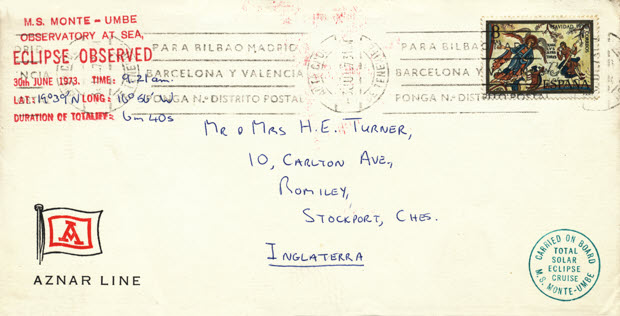
Jueves por la tarde
Excitement really building up now – rows of equipment lined out on the deck and everybody earnestly engaged in testing. There's going to be a real battle for deck space on Saturday, especially with the problem of avoiding the ship's top-hamper.
Patrick [Moore] with his camera crew and Patricia Owtram are rehearsing an interview with somebody – Patrick is booming away – "I've known Kenneth Whatsit for many years now –" CUT! I believe they got up to Take 18 on that one. Half the passengers are standing round taking pix. I don't know whether the interview was finally recorded successfully, but later saw P. & Co. on the other side of the foredeck doing an interview with a man who has got a highly-polished convex mirror and a camera, with which he plans to take a view of the whole sky showing the eclipsed sun, the three planets what will be visible, and the brighter stars. This looked interesting. Not much success for the crew, however; they got up to Take 3 and then abandoned it for the time being.
Saw another flying fish during the afternoon.
Friday, 29th June
In the afternoon we retired to the cabin to prepare our equipment. We have the film and the Sellotape but we had to find some cardboard. Harry took the back off his writing pad and cut out two masks to which we taped strips of film. There was just enough film for the lens of the still camera and, with the aid of a hairdresser's appointment card I found in my bag, a shield to cover the view-finder. Sneaked out on deck with eyes peeled for the Commander, and furtively tried out the effect. It seemed to us to be completely satisfactory.
Lots of entertainment on deck watching everybody finishing off their equipment. Spent some time among the crowd round the BBC team where the Commander, in a Mexican hat and a pair of shorts as broad and blue as the sea, was being interviewed by Patrick. Not much success: they kept shifting the cameras round. Probably not helped by a ring of grinning sight-seers; kids getting on camera; clicking cameras, including three ladies who had drawn up their deckchairs as near as possible and were settled doing a spot of tricoteusing, chatting and tattling.
The sun set in a haze and everybody began to go about looking worried. Of course, we'd expected cloudless blue skies by this time. Went up on deck about 11 p.m.; it was pitch dark, only a few of the brightest stars showing through, and the lights of two passing ships blurred on the obscure horizon.
Not too happy. Somebody said the wind was changing (good? bad?); and it appeared the the Commander had been heard to prophesy that tomorrow's weather would be idea. Decided we had better be up early next day to claim a space on the deck.
The eclipse will start at 9:30 a.m. The sun will be at an altitude of 55o, first contact will take place at the top. Totality about 10:36, eclipse ends about 12 o'clock. Width of totality band: 250 kms. If weather permits, ship to take up position at centre line, totality will last for over 6 minutes, if cloudy, will have to try other positions, which may mean duration of totality cut, possibly drastically.
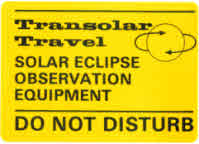 el día 30 sábado – E-day el día 30 sábado – E-day
Up at 6:30 to see the tropical dawn. Quite light outside although the sun was invisible. After a few minutes the clouds high up in the east began to light up, slowly brightening, then a sort of hazy cone of light shone up from the sun's position. The sky slowly brightened, turned palest blue, and suddenly the disk of the sun appeared through the haze, a few degrees above the horizon and looking the colour of the moon seen by daylight. Promising. We were certainly going to see the eclipse.
Harry suggested finding a place aft as the foredeck was crammed; it seemed ideal there, clear of all the rigging, etc., and with the smoke from the funnel blowing away to the west. The bag and binoculars looked very impressive with labels supplied by the travel agent saying: "Solar Eclipse Observation Equipment - DO NOT DISTURB". We attached a few Aznar tie-ons to make extra sure. Even with all this, we caught someone else trying to infiltrate our space when our attention wandered for a moment, so we decided to go down for breakfast separately, leaving one on guard. The deck soon filled up but there was room for all.
By nine o'clock, every bit of space was occupied. The foredeck on the starboard side was bristling with telescopes; a double row of them from stem to amidships. On the port side, reserved for the BBC, nobody had appeared as yet. There was hardly room to put a foot down on the afterdeck.
An announcement in Spanish came over the Tannoy, warning the crew not to watch or try to take photographs without filters, and giving the time of commencement of totality and its duration. The sea was calm and blue, and the ship, with engines on slow, slow, slow, remarkably steady. Next to us, a couple with a 6 in. refractor were trying, not very successfully, to project a steady picture onto a battered box lid. A camera case hung down from the mounting into which they were stuffing bottles of shampoo and hairspray in an attempt to make the right weight for a counterbalance. Perhaps our equipment wasn't so primitive after all!
First contact was timed for 9:21. Towards this time, we started watching the sun through our filters. After a few minutes, I thought I saw a black spot, but it was nearer the top of the disk than I'd expected; someone immediately confirmed it. So this was it! The partial phase of the eclipse had begun and would last an hour and a quarter.
We settled back to watch through the filters, which were perfect. Harry took pictures at roughly 10-minute intervals with various apertures. The couple next to us, with the telescope to project the sun's image, seemed to spend the whole of the partial phase adjusting their counterweight, and oddly enough, hadn't thought of filters for watching.
The moon slowly advanced, first a nibble, then a bite, then a large bite. The sun looked like a large slice of melon, gradually contracted into a banana. Meanwhile all round us the light was gradually dimming. About 15 minutes before totality it was noticeably darker, much colder, the sea was grey, and there was exactly the sinister foreboding atmosphere one reads about. Even a bunch of Spanish sailors, who had come out on the deck below to watch, went quiet.
Maps had been distributed to show the stars and planets we could expect to see in the eclipse-darkened sky – Mercury, Venus and Saturn were well placed, Castor and Pollux because the sun was in Gemini, and the fascinating sight of Orion almost overhead. In the event, the haze hid them all except Venus.
As the last sliver of the sun became narrower and narrower I was watching for the nearest moment of totality so that I could try to see the shadow bands. I looked away momentarily from the sun, and the next instant a gasp went up from the whole ship – "There is it!" Probably most of the amateurs and first-timers completely forgot about shadow bands and Bailey's beads and couldn't take their eyes off the eclipsed sun.
Daylight vanished, there was a round black hole in the sky surrounded by a glowing silvery ring, and beyond that, the corona. We were lucky and had a beautiful corona, pearly-grey spikes all round the sun's disk with long streamers in the plane of the sun's equator, the longest one stretching upwards.
Probably because we are between max. and min. of sunspot activity (last max. in 1968), we had a midway corona, neither the classic winged solar disk nor the evenly spiked corona of minimum. It was dark on deck, not as dark as we'd expected, having been advised that we might need torches to read the scales on the equipment. Harry found it easy to read the figures on the camera. I looked for the stars and planet's we'd been told would be visible, but saw only Venus – too much scattered light to see anything else. There was nothing you really wanted to look at except the eclipse.
Had a look for prominences through the binoculars. In the last day or two, a pair of sunspots had appeared round the limb of the sun , and there had been high hopes of seeing a good prominence, but nothing was evident. Was watching the top of the disk where I thought I could see something like a low prominence – suddenly a brilliant spot broke out to the left – I really thought I had seen a prominence although it wasn't red – then I realized it was the diamond ring effect. Totality was over. I hadn't seen any of the things I'd meant to look for (except Venus), but I'd seen something that I'd never hoped or expected to see.
No one, as far as I know, saw any prominences. As the moon was at its nearest to the earth, and the sun almost at its farthest, the moon's angular diameter was a little larger (than the sun's), so the chromosphere where the prominences originate was completely covered. This difference in the apparent disks was, of course, the reason for the length of totality.
Paradoxically, the more there is to see, the less time you have to see it. Life was ever thus.
The ship had dropped anchor and the engine was ticking over (if ship's engines do that). We were all surprised how steady it was, much more so than anyone had expected. The Captain, seemingly had spent a lot of time working out the position and consulting the weather reports, and he really was to be congratulated on getting us right on the centre line, although totality seemed to us to be over so quickly – we actually had six minutes.
As soon as the first rays of the sun appeared, the whole landscape changed; warmth and light seemed to rush back. Everybody was suddenly happy and relaxed, ready to chat to all and sundry, all we could say was "wonderful", "marvellous", "beautiful", etc. Most people then just went ahead with planning to see the next one!
We were surprised to see most people packing up as soon as totality ended. Before the last phase was half-way over, we had our deck almost to ourselves. We stayed to watch the slow return of the sun's disk; almost to last contact, then we went for lunch feeling really famished – nothing like eclipse-watching for giving you an appetite. At lunch everybody was beaming. A few champagne corks popped, but most of us didn't need any stimulants; we were already aux anges. We heard that Patrick ripped his trousers at the eclipse and he was going around with a large gap in a trouser leg till a kind female admirer offered to mend it.
No sign of the Canberra; heard afterwards she had had bad weather reports by satellite and had found a (presumably) haze-free window about 200 miles away from our position. I wondered if we might see or hear the Concorde, but no sign of that either; however, as someone remarked, a sonic boom just as totality was beginning could have wrecked a few people's carefully arranged experiments!
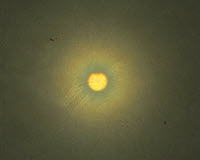 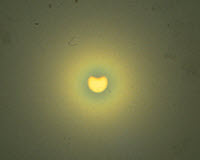 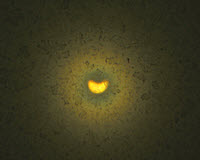
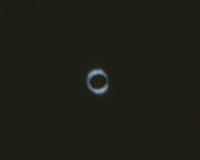 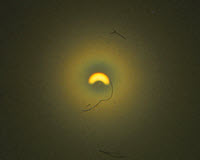 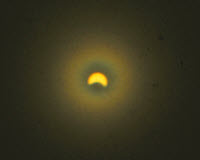
1973 total solar eclipse photographs by Harry Turner
Found some interesting-looking papers in the señoras' loo about Mauritania and the eclipse and decided to borrow them, have a quick read, then put them back. However, there was so much of interest in them that I decided to keep them longer and copy some of the information out. Probably left there by a Transolar courier. Finally after a quick battle with my conscience, I decided to add this material to my eclipse souvenirs. Very low, I know, just like pinching towels from hotels or cutlery from British Rail. Shall give it back if I see anybody apparently looking for it.
Circa 6 p.m.
I had collapsed in bed; then a commotion on the prom deck outside roused me. Went out in time to see the Mauritanian pilot come aboard. A gale was blowing by this time. Shortly afterwards, we had the first view of West Africa. The wind was so strong I could hardly hold the binoculars steady. As we drew nearer to land, I chivvied Harry out to take pix. Stayed on deck to see docking at Nouadhibou. Passengers taking photos of natives in long blue robes, natives taking photos of passengers.
After dinner we went ashore, exchanged passports for 24-hour safe conducts. They speak French, English and Spanish here, so no bother. We walked further inland but decided to leave exploration till tomorrow in daylight. Transolar announced an excursion at 350 ptas each, limited to 170 people. Doubtful about this. Finally decided to share taxi with Mr. & Mrs. Strach and leave early in the morning. Went on shore again to change £5 sterling for brand new ouguiyas which, oddly enough, are worth 100 to the £. Apparently, the currency was revalued recently – probably as soon as they heard the Monte Umbe was on the way.
The ship was dressed overall with fairy lights, even down the gangway. Looks good from the shore. Someone was spreading a rumour that Transolar had commandeered all the taxis in Nouadhibou for excursions. Hope to prove this wrong.
El diá premiero de julio – domingo
These last two days have been crammed so full, we are all a little bit dazed! Saturday morning (only yesterday!) The eclipse; Saturday afternoon, first sight of the African coast and first landing at Nouadhibou. Sunday morning – visit to Nouadhibou.
Up early again today – not to see a tropical dawn this time but to get down early for breakfast and set off for Nouadhibou – got away about 8:30. No trouble getting a taxi – driver asked for 200 francs, some discussion about ouguiya, driver said c'est la même chose, still 200. When we arrive at the town, Harry gives him a 10 ouguiya note. – he looks a bit sulky but doesn't make a fuss, reluctantly gives rather vague instructions to the direction of the post office.
A quick look at the market, nothing much doing, too early. Very pretty girl with a baby on her back poses for pictures si vous donnez un cadeau. Mr. S. Gives her a coin, everybody round about wants un cadeau as well. Make an escape and find post office, where a few people are hanging about. We manage to find out that it doesn't open until nine o'clock, so take a walk in the sand towards the dunes. Goats everywhere, a few wretched cows chewing miserably at some dried-up stuff.
A little boy, who has attached himself to us and who speaks French, proudly points out the local cinema. Didn't manage to see what was showing. Not far away there is a yellow-washed building with, oddly enough, a cross on top. We consult our guide – une mosquée? Non, cest l'église. We spend a few minutes looking at the neat, clean, beautifully simple little church, with its small congregation waiting for mass to begin. We speak to the French father who tells us that we may take pictures.
Back to the post office, still not open. The Spanish couple from the Monte Umbe come up and a conversation in French, Spanish and English establishes that although the post office opens, it doesn't sell stamps on a Sunday. One of the natives mentions Cansado, where we would be able to get stamps today. Cansado – where's that? Which way? Better take taxi, he says. Taxi? How far? Trente kilometres! So that's it for the stamps.
Intrigued by a notice outside the post office giving instructions to the people in Arabic and in French about watching the eclipse and the danger to the eyes. You wouldn't want to risk blindness through watching the eclipse? Non Non Non Non Non Non Non Non.
Special filters for watching were supplied by the local Red Cross, free to anyone who wished to have them. I'd have loved to add this notice to my collection of souvenirs but hadn't the nerve to take it down.
Back to the market where with the arrival of two coach-loads from the Monte Umbe, things are really coming alive. A bewildering variety of types and costumes – some of the men are very dignified in blue and white robes, like a long sheet with an opening for the neck, sides left open, and a sort of embroidered pocket sewn to the front. A good many of the women are all in black, others in brilliant, even very elaborate robes. The children were lovely; merry friendly brown eyes, interested in everything but not in the least cheeky. Even our little guide didn't ask for money, when we looked for him to give him some coins, he had disappeared.
Nothing really interesting to buy; except some silver jewellery which looked good but was very dear. Bargaining was the order of the day – not too easy to sort out money from currencies on the go – pesetas, sterling, African francs and the new ouguiya. Some were dubious about taking pesetas, but pound notes seemed to be accepted anywhere.
Took pictures of the scene; several times chased away resentfully by women who threw sand and gravel. Baking heat, all very thirsty and sticky.
Odd thoughts:
The situation on Monte Umbe now is that you only have to mention the word Nouadhibou to raise a laugh. Somebody won a prize at the fancy-dress parade dressed as a camel-driver with a notice "Hire a Camel. Tel. Nouadhibou 1".
Patrick starts his lecture: "A funny thing happened to me on the way to Nouadhibou . . ." and everybody falls about.
Sunday afternoon
En route for the Canaries again, very strong head wind and quite heavy seas. In the morning, I was roasting in a very light cotton dress and practically nothing else, but to go out on deck after dinner, I had to put my coat on. Not really a cold wind, just very rough. Quite a few empty seats at dinner.
Went out 8:30 p.m. to watch waves – had to tear myself away. Finally, decided to go back to cabin and come out later. On the way through información saw some eclipse photos on display, 75 ptas. each. Ordered 3, one of full totality, one showing diamond ring effect, one showing the nearly-eclipsed sun looking like a slice of melon.
The old ship creaking like mad tonight. Unusually our door vibrates and we have to wedge it shut. Then the water jug begins to rattle in its holder; last night I had to get up to remove it. Tonight with the heavier motion of the ship, all the small noises have ceased and there's one large creak which goes steadily on. Suppose we'll learn to live with it!
We seem to have been lucky with our cabin, it appears to be roomier than a lot of them. Being on the outside with a window is also a big advantage, lots of the cabins have no window at all, which must be terribly claustrophobic.
Monday, 2nd July
On our way from Nouadhibou to Tenerife. Writing this on Wed. night, and find to my surprise that I've lost Monday altogether, can't remember a thing about it. I know that it must have been on Monday that I went to the talk on the solar corona – yes, it's coming back. There was a lot to fit in on Monday – talk, changing our travellers cheques ready for Tenerife, buying postcards ready to have the eclipse observed franking put on them, getting stamps.
In the event, the eclipse franking was postponed from 10:30 a.m. to the evening, we were wondering how this would fit in with the after-dinner visit we were hoping to make to Santa Cruz, as at that time we expected the ship to arrive there about 7 p.m. The weather continuing rough, with strong wind, the announcement was made that the ship's speed would be reduced for the sake of the passengers so arrival at Santa Cruz would not be until midnight. Great disappointment all round; this means only one day at Tenerife, and a short one at that, because the ship must leave at 17:00 hours.
As most of the day will be taken up by the excursion, which is due to return at 16:00 hours and bound to be late, judging by the Las Palmas one, we simply won't have time to see Santa Cruz or do any shopping. Agonizing about whether to go on the excursion or stay behind and spend the day looking around.
Last postcards bought, written, stamped, franked, posted. Spent the evening playing scrabble. Sea still rough when we went to bed. Looked out just after 11 p.m. and could see a lighted shore on the port side. We should be at Santa Cruz in an hour's time.
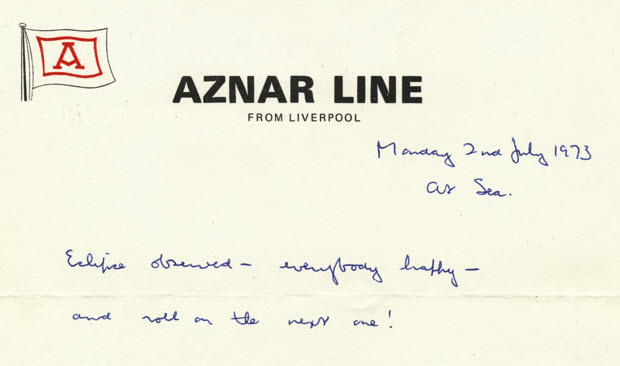
Memo to self: eclipse observed
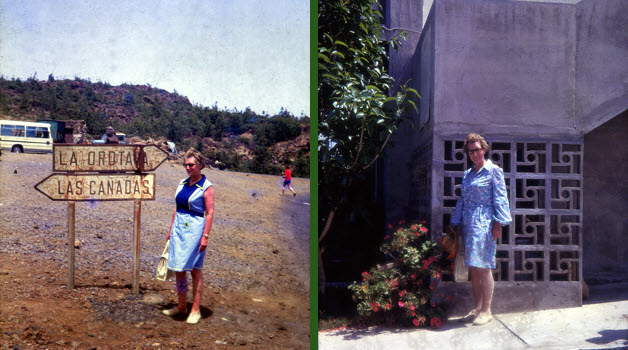
On Tenerife
Friday, 6th July
Rather reluctant to get up after night spent trying to ignore the sailing rattle. At breakfast table was Mr. McGee's sister (or sister-in-law), who remarked that normally these cruises were aimed at middle-aged or retired working-class people, which explains – I suppose this is a bit snobbish – the atmosphere of a floating Butlin's which would have prevailed if the astronomical party hadn't taken matters into its own hands. I'm realising more and more how odd this bunch must have seemed to the crew and staff.
I didn't attend the talk on skin care and make-up by the senior hostess – she's the hard-boiled lady who's perpetually calling for a big round of applause, not the attractive one with the warm voice and Spanish eyes. Heard afterwards that she had recommended using Brylcreem on the skin to get a nice even tan – well, well, now they tell us, after we've spent umpteen pesetas on Ambré Solaire Lêche Hydrante.
A talk on planetary occultations was rather technical but interesting in showing the amount of work still to be done on our own doorstep in calculating exact positions of planets, and their diameters and those of their satellites – a good many ideas revised recently on satellites with regard to diameter, extent of atmosphere, and hence density. Even star positions still not sufficiently accurate in many cases. Always interesting to hear of work that can be done by amateurs without large telescopes or elaborate equipment. One so often tends to feel that astronomy has passed into the computer and billion dollar telescope domain, leaving nothing for the amateurs but star-gazing as an end in itself.
Show of slides by various amateurs – possibly of more interest to photographers. Some slides of Dundee Observatory – only one in the country owned and run by local authority. Also pictures of 1954 eclipse, seen from Sweden, the first BAA [British Astronomical Association] eclipse expedition. Said to be finest corona of recent eclipses. Have slightly more hope of our pictures coming out since seeing this. Pictures of cloud-obscured Toronto eclipse; that must have been a frustrating experience, as partial phase was seen quite well, clouds only building up near totality.
Pearly-grey sunset tonight, the sun casting a wide cone of rays down into the sea and running a gilt-edge along the horizon. Contrast with last night's molten-gold sunset.
At 8 p.m. a formal presentation was made to the Captain in Los Robles – lights, cameras and all laid on. Patrick introduced the ceremony, then handed over to the Commander, who informed us that if you had commanded (as he had, of course) you knew how to recognise a well-run one with a good captain; most of us felt that we had already noticed how efficiently everything was run without necessarily being old sea-dogs. The Captain received a radio in the shape of a helmet, silver candlesticks, a silver rose-bowl – someone had evidently bought up the contents of the ship's shop! However, it was the thought that counted. The captain made a brief speech of acknowledgement, and everybody was genuinely glad that his part in the success of an adventure had been recognised.
Wednesday 11th July
Tonight, we shall be able to watch the Sky at Night programme, parts of which we saw being filmed on the deck of the Monte Umbe.
What We Learned
- The apparent diameter of the sun is 32 minutes with possible fluctuations either way of 0.5'.
- The apparent diameter of the moon is 31' with possible fluctuations of 1.3'.
- The greatest width ever reached by the moon's shadow on earth is over 250 km (typically 100-160 km).
- The shadow travels with a velocity almost the same as that of the moon itself (200 mps) (because of the great distance of the sun compared with that of the moon) namely at a rate 60 times the earth's circumference in 27 days, or 2.2 times the earth's circumference in one day.
- While the earth's surface is travelling from west to east in its diurnal rotation, the moon's shadow travels in the same direction but at least more than twice as fast. The track of the shadow begins in the west with the sun just rising and after about 6 hours of contact with the earth, ends in the east with the sun setting. Maximum duration, very rarely reached, is 8 minutes.
- The moon takes 29.531 days to overtake the sun; the sun takes 346.6 days to make a circuit back to one of the moon's nodes. 6585.3 days (a common multiple of these two periods) contains exactly 223 lunar months and 19 revolutions with respect to the node. 6585.3 days also contains 239 revolutions of the moon with respect to its greatest and least distance, which occupy 27.555 days. Therefore, after 18 years 11⅓ days (or 10⅓ if 5 leap years are included) what is substantially the same eclipse track will be repeated.
- At each recurrence, owing to the odd one-third of a day, it will be shifted westwards about 120 degrees in longitude, and will only come back after 3 cycles to approximately the same place on the map. This period of 18 years 11⅓ days is the Saros.
- Halley was the first to search for information from ancient eclipses and he found the material too shaky to be demonstrative. Many eclipses are mentioned in mediaeval or ancient writings, but, except for those of professed astronomers such as Albategnius or Ptolemy, not a single one of them, standing alone, can be said to have any chronological significance, so little importance did the chroniclers give to the details of time and place.
- If these details were exactly given they would be delicate tests of the permanence of the moon's and sun's orbit and motion. Selon Newcomb, when an eclipse is mentioned in ancient literature without statement of place, it has been the custom to write it down as total at the capital of the author's country – the proper conclusion being that its phase is unknown and that it took place at an unknown distance from the author's dwelling, and yet not too far away for him to have heard of it.
Hard Luck Tales
There is in the Observatory of Meudon a picture which represents Paris at night invested by the Prussian lines. A balloon is floating in the sky and in this balloon was Janssen, making his way out of the beleaguered city to observe the solar eclipse of 1870. Unfortunately it was cloudy.
Newcomb travelled over land and water, chiefly in a canoe, for six weeks, to see the eclipse of 1860 in North-West Canada. This was cloudy too.
Marion, Harry and Philip Turner travelled overnight by train to Penzance in Cornwall to view the 1999 eclipse. Guess what?
General Information
Observations made at the eclipse of May 20 1919 were the first to confirm the deflection of light due to gravity, as predicted by Einstein.
On July 5th 2168, there will be an eclipse of almost maximum duration: 7 minutes 28 seconds. Total eclipses visible from the British Isles in the last 500 years: June 26th 1424, June 17th 1433, March 6th 1598, April 8th 1652, May 2nd 1715, May 22nd 1724.
On July 28th 1851, the first attempt was made to photograph the corona. The first use of a spectroscope was in 1868. On August 7th 1869, the first observations of a green line in the spectrum of the corona were made and the discovery of coronium. On December 28th 1870, the discovery of the reversing layer; flash spectrum observed at subsequent eclipses.
During the total eclipse of 1733, a Swedish observer, Wassenius, described the solar prominences as red clouds in the moon's atmosphere. It was only after the eclipse of 1851 that astronomers became certain that the corona and prominences were connected with the sun and not with the moon.
August 11th 1999 – totality track passes through Cornwall.
October 7th 2135, next totality visible over British Isles.
<<<<<>>>>>
reconstructed from overlapping contemporary notes & reflections
Harry's account of The Eclipse of the Century is HERE
|

